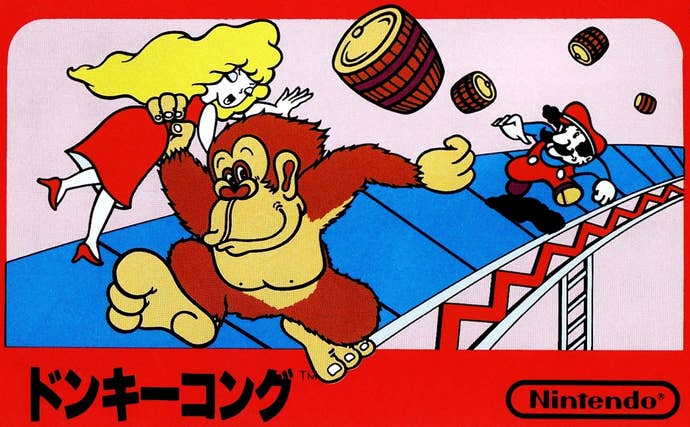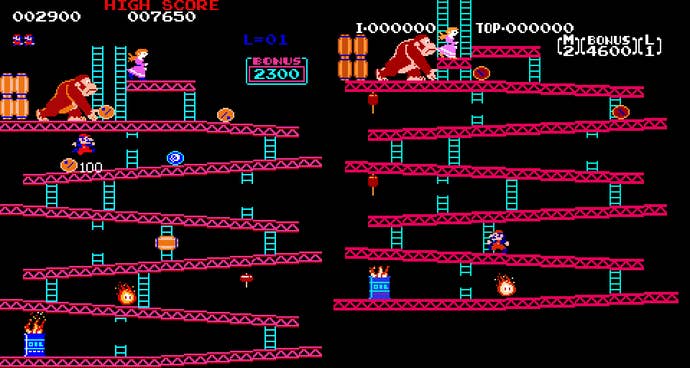Virtual Spotlight: Donkey Kong
For Nintendo, this is where it all began.
This article first appeared on USgamer, a partner publication of VG247. Some content, such as this article, has been migrated to VG247 for posterity after USgamer's closure - but it has not been edited or further vetted by the VG247 team.
Virtual Spotlight takes a look at the most interesting (not necessarily the best) weekly release for Nintendo's Virtual Console. We'll also look at PlayStation Network/PS1 classics, on the rare occasion Sony remembers those exist. This week: We've talked about the impact of Donkey Kong a lot in our Famicom and Sega SG-1000 retrospectives; now let's talk about the game itself.
As the latest in Nintendo's 30th anniversary celebration titles -- a series of Wii U Virtual Console titles sold for 30 cents for 30 days to mark 30 years since the Famicom's launch -- Donkey Kong has quite appropriately arrived on the system's 30th birthday. After all, it was Donkey Kong that helped give the Famicom a critical edge over Sega's SG-1000 and the MSX computer platform, both of which launched simultaneously with the Famicom.
Donkey Kong has a long and storied history both at home and in the arcades, but one fact remains consistent: It was a huge hit for the company and effectively put Nintendo on the map as an entity to be reckoned with. The original coin-op version was created in an act of desperation as Nintendo badly misjudged the overseas appeal of its Space Invaders-derived shooter Radarscope and ended up with a warehouse full of the thing. Shigeru Miyamoto was given the task of coming up with a way to salvage those unwanted cabinets and came up with a game inspired in equal parts by King Kong and Popeye: A massive ape abducts a beautiful lady, and a brave carpenter ascends stage of stage of hazards to confront the ape and rescue his love. It was a tremendous hit, far greater than Nintendo could have hoped, and turned the company's fortunes around. For years, Nintendo had been making toys based on properties licensed from others; suddenly, they had the property that everyone else coveted.

Donkey Kong and his rival Mario made their way into homes around the world in the form of cereals, stickers, toys, and even a Saturday morning cartoon. The game itself established the rules of the platformer genre, and helped solidify the concept of video games as narrative -- sure, its simple pantomime isn't much to look at now, but it was far more concrete and immediate than the stories offered by contemporary text adventures like Zork. Beside the opening and ending mini-movies that demonstrated the rampage and comeuppance of Kong, the stages themselves told a story... most notably the final stage, in which Mario corners the massive ape at the top of a construction project and, rather than facing the ape head-on and getting squashed like a bug, causes the girders to collapse from beneath Kong, knocking him cold. (Damsel Pauline, luckily, was stranded on a girder slightly wider than the gap created by Kong's fall, so her perch simply dropped a level and led her to safety.)
The home rights for Donkey Kong became a heated contest. Every platform holder vied to license the game and outdo the competition with the most perfect rendition possible. Atari's 2600 gave it the best try it could manage, while the Intellivision version looked a bit nicer. Coleco's port was considerably superior, though the difference in arcade and home screen resolutions forced them to shave a tier off the first level's girders. Unfortunately, Kong also caused a massive headache for Coleco when they mistakenly assumed they had the right to the home computer version (which in fact belonged to Atari) and demoed a magnificent ADAM version of the game for Nintendo's notoriously hot-headed president, Hiroshi Yamauchi, who was not amused at their abrogation of the license. Thankfully, no one died that day, but we can only assume a lot of doctor's appointments involving spiking blood pressure happened shortly thereafter.

In the end, though, the truest take on Donkey Kong came from Nintendo itself. While the game was two years old by the time the Famicom launched in Japan, Kong still held enough gamers in thrall that an almost pixel-perfect recreation of the coin-op experience held considerable sway over the market. Careful examination would reveal some imperfections -- the slightly smaller vertical screen dimensions of the Famicom meant Nintendo's designers had to do some clever jiggering to make everything fit, but they managed to compress all the features of every board into the viewing area without compromising the playability. Well, almost every board; the second stage, the cement factory, was cut entirely for reasons of space.
Alas, that's the version Nintendo has chosen to put on Wii U; the fascinating "restored" version released as a limited giveaway for 3DS owners last fall remains unavailable for purchase by the general public. It's a shame that such an essential, historical game has never properly been preserved for the masses, but the arcade version appears to be locked away due to some sort of legal battle, and the revamped home port is exclusive to whichever 3DS owners had the good sense (and the fortunate budget) to register their games last year.
Nevertheless, Donkey Kong is a fun, if brief and unfortunately incomplete, piece of gaming history. Now, 30 years after it catapulted Nintendo into the console scene, it's worth playing just to see where it all started... especially when the cost of entry is a mere 30 cents.
ConclusionAn important (albeit incomplete, at least in this incarnation) piece of video game history, some form of Donkey Kong should be in any serious gamer's library.








